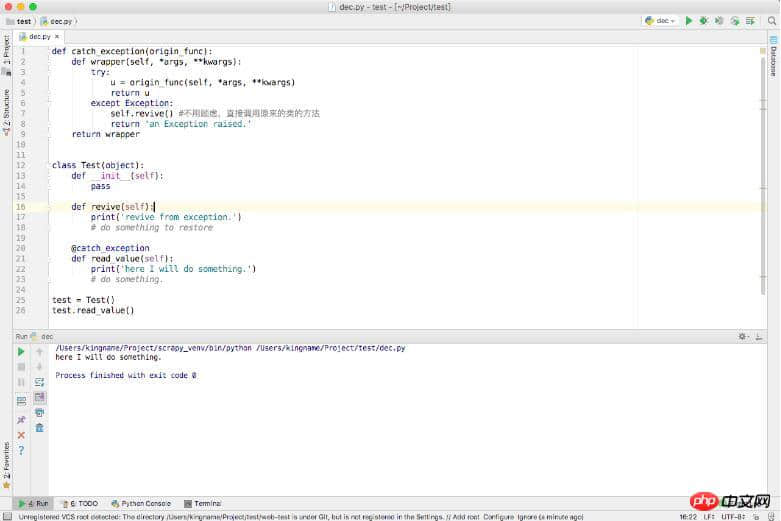本文摘自php中文网,作者不言,侵删。
下面为大家分享一篇基于Python 装饰器装饰类中的方法实例,具有很好的参考价值,希望对大家有所帮助。一起过来看看吧title: Python 装饰器装饰类中的方法
comments: true
date: 2017-04-17 20:44:31
tags: ['Python', 'Decorate']
category: ['Python']
---
目前在中文网上能搜索到的绝大部分关于装饰器的教程,都在讲如何装饰一个普通的函数。本文介绍如何使用Python的装饰器装饰一个类的方法,同时在装饰器函数中调用类里面的其他方法。本文以捕获一个方法的异常为例来进行说明。
有一个类Test, 它的结构如下:
1 2 3 4 5 6 7 8 9 | class Test(object):
def __init__(self):
pass
def revive(self):
print('revive from exception.')
# do something to restore
def read_value(self):
print('here I will do something.')
# do something.
|
在类中有一个方法read_value(),这个方法在多个地方被调用。由于某些原因,方法read_value有可能随机抛出Exception导致程序崩溃。所以需要对整个方法做try ... except处理。最丑陋的做法如下面的代码所示:
1 2 3 4 5 6 7 8 9 10 11 12 13 14 | class Test(object):
def __init__(self):
pass
def revive(self):
print('revive from exception.')
# do something to restore
def read_value(self):
try:
print('here I will do something.')
# do something.
except Exception as e:
print(f'exception {e} raised, parse exception.')
# do other thing.
self.revive()
|
这样写虽然可以解决问题,但是代码不Pythonic。
使用装饰器来解决这个问题,装饰器函数应该写在类里面还是类外面呢?答案是,写在类外面。那么既然写在类外面,如何调用这个类的其他方法呢?
首先写出一个最常见的处理异常的装饰器:
1 2 3 4 5 6 7 8 9 10 11 12 13 14 15 16 17 18 | def catch_exception(origin_func):
def wrapper(*args, **kwargs):
try:
u = origin_func(*args, **kwargs)
return u
except Exception:
return 'an Exception raised.'
return wrapper
class Test(object):
def __init__(self):
pass
def revive(self):
print('revive from exception.')
# do something to restore
@catch_exception
def read_value(self):
print('here I will do something.')
# do something.
|
这种写法,确实可以捕获到origin_func()的异常,但是如果在发生异常的时候,需要调用类里面的另一个方法来处理异常,这又应该怎么办?答案是给wrapper增加一个参数:self.
代码变为如下形式:
1 2 3 4 5 6 7 8 9 10 11 12 13 14 15 16 17 18 19 | def catch_exception(origin_func):
def wrapper(self, *args, **kwargs):
try:
u = origin_func(self, *args, **kwargs)
return u
except Exception:
self.revive() #不用顾虑,直接调用原来的类的方法
return 'an Exception raised.'
return wrapper
class Test(object):
def __init__(self):
pass
def revive(self):
print('revive from exception.')
# do something to restore
@catch_exception
def read_value(self):
print('here I will do something.')
# do something.
|
只需要修改装饰器定义的部分,使用装饰器的地方完全不需要做修改。
下图为正常运行时的运行结果:

下图为发生异常以后捕获并处理异常:

通过添加一个self参数,类外面的装饰器就可以直接使用类里面的各种方法,也可以直接使用类的属性。
相关推荐:
python装饰器-限制函数调用次数的方法(10s调用一次)
以上就是基于Python 装饰器装饰类中的方法的详细内容,更多文章请关注木庄网络博客!!
相关阅读 >>
Python实现去除列表中重复元素的方法
Python中基本的数据结构--列表
Python怎么样输出九九乘法表
Python学成后做什么
Python共发布过哪些版本
什么是Python re.compile 函数?
Python中常用列表方法分享
Python实现switch/case语句的方法
什么是Python类属性?类的私有属性是什么?(实例解析)
Python中文输出报错解决方案(实例教程)
更多相关阅读请进入《Python》频道 >>

人民邮电出版社
python入门书籍,非常畅销,超高好评,python官方公认好书。
转载请注明出处:木庄网络博客 » 基于Python 装饰器装饰类中的方法







